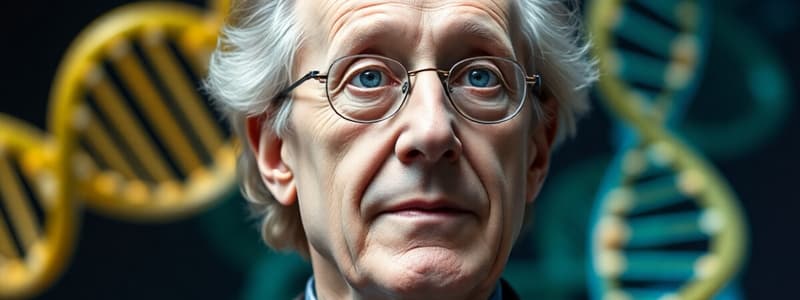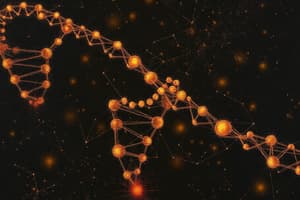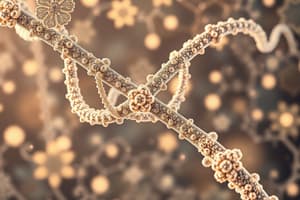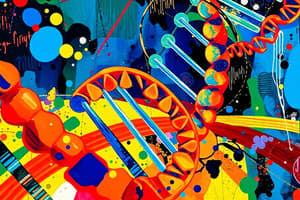Podcast
Questions and Answers
What was the primary approach used by Crick and Watson to determine the structure of DNA?
What was the primary approach used by Crick and Watson to determine the structure of DNA?
- Relying solely on X-ray crystallography data obtained from Rosalind Franklin.
- Conducting extensive laboratory experiments with various chemicals and compounds.
- Performing detailed analyses of viral DNA sequences and comparing them with known genetic information.
- Constructing 3D models based on known chemical and physical properties of DNA molecules. (correct)
Which of the following best describes Sydney Brenner's contribution to molecular biology?
Which of the following best describes Sydney Brenner's contribution to molecular biology?
- Synthesizing the first artificial DNA molecule, paving the way for modern genetic engineering.
- Providing critical X-ray crystallography data that helped determine the structure of DNA.
- Leading the team at King's College London that first identified DNA as the carrier of genetic information.
- Discovering the encoding process for amino acids and researching organ development and apoptosis. (correct)
Which of the following statements is most accurate regarding the knowledge of DNA components prior to Crick and Watson's discovery?
Which of the following statements is most accurate regarding the knowledge of DNA components prior to Crick and Watson's discovery?
- The precise arrangement of nucleotide bases (A, T, G, C) within the DNA molecule was already established and widely accepted.
- Scientists were unaware that DNA had the ability to transmit genetic information or replicate itself.
- The role of phosphoric acid and sugar in forming the DNA backbone was still unknown and under debate.
- The presence of the four nucleotide bases and the sugar-phosphate backbone was known, but their arrangement and role in replication were not understood. (correct)
What was the significance of the approach adopted by Crick and Watson in their discovery of DNA's structure, compared to traditional research methods?
What was the significance of the approach adopted by Crick and Watson in their discovery of DNA's structure, compared to traditional research methods?
How long did it take for Crick and Watson to publish their revolutionary findings after they started researching DNA's structure?
How long did it take for Crick and Watson to publish their revolutionary findings after they started researching DNA's structure?
Flashcards
DNA Structure
DNA Structure
DNA consists of a sugar-phosphate backbone and four bases: A, T, G, C.
Key Figures in DNA Discovery
Key Figures in DNA Discovery
Rosalind Franklin, Maurice Wilkins, and Linus Pauling were pivotal in understanding DNA.
Crick and Watson's Approach
Crick and Watson's Approach
They built 3D models of DNA to uncover its structure rather than conducting exhaustive experiments.
Sydney Brenner's Contribution
Sydney Brenner's Contribution
Signup and view all the flashcards
Rosalind Franklin's Data
Rosalind Franklin's Data
Signup and view all the flashcards
Study Notes
Nobel Prize-Winning British Biophysicist Francis Crick
- Crick was celebrated for his 1953 discovery of DNA's structure
- This was one of the most significant breakthroughs in scientific history
Crick's Early Life and Career
- Crick studied physics at University College London and later worked for the Royal Navy
- During World War II, he helped develop magnetic and acoustic devices
- He later decided to focus on biology
- Became a post-doctoral researcher in 1949 at the Cavendish Laboratory in Cambridge
- Studied X-ray diffraction of proteins
Crick's Collaboration with Watson
- Met James Watson, with whom he collaborated in the race to discover the structure of DNA
- In 1954, Crick completed his PhD and contributed to the ongoing study of the genetic code
- Crick moved to California in 1976, and there studied developmental neurobiology and human consciousness
DNA Structure Discovery
- Crick and Watson worked together
- They compiled evidence from other scientists
- Combined knowledge of disciplines, including viral genetics, physics, and X-ray crystallography
- Successfully developed a model of DNA
- Published a landmark co-authored paper in Nature on April 25, 1953
- The paper revealed the structure of DNA
Impact of Crick's Work
- Understanding of heredity and development advanced
- The study of DNA's structure and function had a revolutionary impact on the field of molecular biology
- Advanced medicine, gene therapy, and genetic manipulation.
Studying That Suits You
Use AI to generate personalized quizzes and flashcards to suit your learning preferences.





